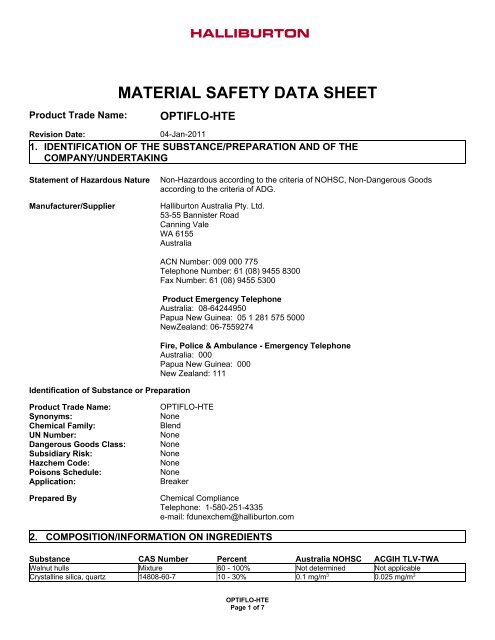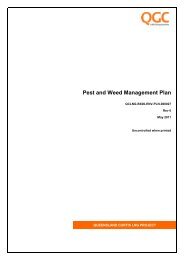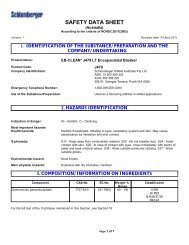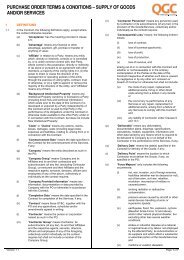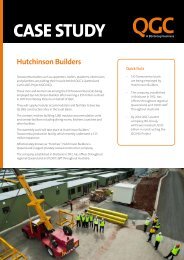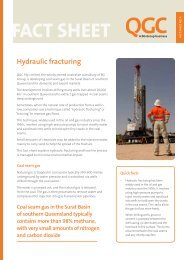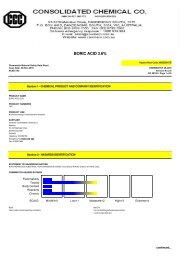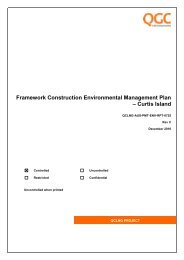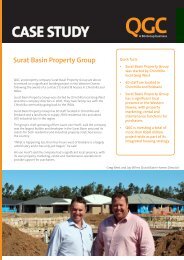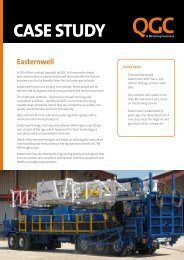Optiflo HTE - Australia Pacific LNG
Optiflo HTE - Australia Pacific LNG
Optiflo HTE - Australia Pacific LNG
Create successful ePaper yourself
Turn your PDF publications into a flip-book with our unique Google optimized e-Paper software.
Product Trade Name:<br />
MATERIAL SAFETY DATA SHEET<br />
OPTIFLO-<strong>HTE</strong><br />
Revision Date:<br />
04-Jan-2011<br />
1. IDENTIFICATION OF THE SUBSTANCE/PREPARATION AND OF THE<br />
COMPANY/UNDERTAKING<br />
Statement of Hazardous Nature<br />
Manufacturer/Supplier<br />
Non-Hazardous according to the criteria of NOHSC, Non-Dangerous Goods<br />
according to the criteria of ADG.<br />
Halliburton <strong>Australia</strong> Pty. Ltd.<br />
53-55 Bannister Road<br />
Canning Vale<br />
WA 6155<br />
<strong>Australia</strong><br />
Identification of Substance or Preparation<br />
ACN Number: 009 000 775<br />
Telephone Number: 61 (08) 9455 8300<br />
Fax Number: 61 (08) 9455 5300<br />
Product Emergency Telephone<br />
<strong>Australia</strong>: 08-64244950<br />
Papua New Guinea: 05 1 281 575 5000<br />
NewZealand: 06-7559274<br />
Fire, Police & Ambulance - Emergency Telephone<br />
<strong>Australia</strong>: 000<br />
Papua New Guinea: 000<br />
New Zealand: 111<br />
Product Trade Name:<br />
Synonyms:<br />
Chemical Family:<br />
UN Number:<br />
Dangerous Goods Class:<br />
Subsidiary Risk:<br />
Hazchem Code:<br />
Poisons Schedule:<br />
Application:<br />
Prepared By<br />
OPTIFLO-<strong>HTE</strong><br />
None<br />
Blend<br />
None<br />
None<br />
None<br />
None<br />
None<br />
Breaker<br />
Chemical Compliance<br />
Telephone: 1-580-251-4335<br />
e-mail: fdunexchem@halliburton.com<br />
2. COMPOSITION/INFORMATION ON INGREDIENTS<br />
Substance CAS Number Percent <strong>Australia</strong> NOHSC ACGIH TLV-TWA<br />
Walnut hulls Mixture 60 - 100% Not determined Not applicable<br />
Crystalline silica, quartz 14808-60-7 10 - 30% 0.1 mg/m 3 0.025 mg/m 3<br />
OPTIFLO-<strong>HTE</strong><br />
Page 1 of 7
Total to 100%<br />
3. HAZARDS IDENTIFICATION<br />
Hazard Overview<br />
CAUTION! - ACUTE HEALTH HAZARD<br />
May cause eye and respiratory irritation. May cause allergic respiratory reaction.<br />
DANGER! - CHRONIC HEALTH HAZARD<br />
Breathing crystalline silica can cause lung disease, including silicosis and lung<br />
cancer. Crystalline silica has also been associated with scleroderma and kidney<br />
disease.<br />
This product contains quartz, cristobalite, and/or tridymite which may become<br />
airborne without a visible cloud. Avoid breathing dust. Avoid creating dusty<br />
conditions. Use only with adequate ventilation to keep exposures below<br />
recommended exposure limits. Wear a NIOSH certified, European Standard EN<br />
149, or equivalent respirator when using this product. Review the Material Safety<br />
Data Sheet (MSDS) for this product, which has been provided to your employer.<br />
Hazard Ratings<br />
Flammability: 0<br />
Toxicity: 0<br />
Body Contact: 0<br />
Reactivity: 0<br />
Chronic: 3<br />
Scale: Min/Nil=0 Low=1 Moderate=2 High=3 Extreme=4<br />
4. FIRST AID MEASURES<br />
Inhalation<br />
Skin<br />
Eyes<br />
Ingestion<br />
Notes to Physician<br />
If inhaled, remove from area to fresh air. Get medical attention if respiratory irritation<br />
develops or if breathing becomes difficult.<br />
Wash with soap and water. Get medical attention if irritation persists.<br />
In case of contact, immediately flush eyes with plenty of water for at least 15 minutes<br />
and get medical attention if irritation persists.<br />
Do not induce vomiting. Slowly dilute with 1-2 glasses of water or milk and seek<br />
medical attention. Never give anything by mouth to an unconscious person.<br />
Not Applicable<br />
5. FIRE FIGHTING MEASURES<br />
Suitable Extinguishing Media<br />
Unsuitable Extinguishing Media<br />
Special Exposure Hazards<br />
Water fog, carbon dioxide, foam, dry chemical.<br />
None known<br />
Decomposition in fire may produce toxic gases. Organic dust in the presence of an<br />
ignition source can be explosive in high concentrations. Good housekeeping<br />
practices are required to minimize this potential.<br />
Special Protective Equipment for<br />
Fire-Fighters<br />
Full protective clothing and approved self-contained breathing apparatus required for<br />
fire fighting personnel.<br />
OPTIFLO-<strong>HTE</strong><br />
Page 2 of 7
6. ACCIDENTAL RELEASE MEASURES<br />
Personal Precautionary Measures Use Appropriate protective equipment. Avoid creating and breathing dust.<br />
Environmental Precautionary<br />
Measures<br />
Procedure for<br />
Cleaning/Absorption<br />
None known.<br />
Collect using dustless method and hold for appropriate disposal. Consider possible<br />
toxic or fire hazards associated with contaminating substances and use appropriate<br />
methods for collection, storage and disposal.<br />
7. HANDLING AND STORAGE<br />
Handling Precautions<br />
Storage Information<br />
Avoid contact with eyes, skin, or clothing. This product contains quartz, cristobalite,<br />
and/or tridymite which may become airborne without a visible cloud. Avoid breathing<br />
dust. Avoid creating dusty conditions. Use only with adequate ventilation to keep<br />
exposure below recommended exposure limits. Wear a NIOSH certified, European<br />
Standard En 149, or equivalent respirator when using this product. Material is<br />
slippery when wet.<br />
Store in a cool, dry location. Use good housekeeping in storage and work areas to<br />
prevent accumulation of dust. Close container when not in use. Product has a shelf<br />
life of 24 months<br />
8. EXPOSURE CONTROLS/PERSONAL PROTECTION<br />
Engineering Controls<br />
Respiratory Protection<br />
Use approved industrial ventilation and local exhaust as required to maintain<br />
exposures below applicable exposure limits listed in Section 2.<br />
Wear a NIOSH certified, European Standard EN 149, or equivalent respirator when<br />
using this product.<br />
Hand Protection<br />
Skin Protection<br />
Eye Protection<br />
Other Precautions<br />
Normal work gloves.<br />
Wear clothing appropriate for the work environment. Dusty clothing should be<br />
laundered before reuse. Use precautionary measures to avoid creating dust when<br />
removing or laundering clothing.<br />
Wear safety glasses or goggles to protect against exposure.<br />
None known.<br />
9. PHYSICAL AND CHEMICAL PROPERTIES<br />
Physical State:<br />
Solid<br />
Colour:<br />
Dark black red<br />
Odour:<br />
Fermentation<br />
pH:<br />
Not Determined<br />
Specific Gravity @ 20 C (Water=1): 1.5<br />
Density @ 20 C (kg/l):<br />
Not Determined<br />
Bulk Density @ 20 C (kg/l):<br />
Not Determined<br />
Boiling Point/Range (C):<br />
Not Determined<br />
Freezing Point/Range (C):<br />
Not Determined<br />
Pour Point/Range (C):<br />
Not Determined<br />
Flash Point/Range (C):<br />
Not Determined<br />
Flash Point Method:<br />
Not Determined<br />
Autoignition Temperature (C):<br />
Not Determined<br />
Flammability Limits in Air - Lower (g/m 3 ):<br />
Not Determined<br />
Flammability Limits in Air - Lower (%):<br />
Not Determined<br />
OPTIFLO-<strong>HTE</strong><br />
Page 3 of 7
9. PHYSICAL AND CHEMICAL PROPERTIES<br />
Flammability Limits in Air - Upper (g/m 3 ):<br />
Flammability Limits in Air - Upper (%):<br />
Vapour Pressure @ 20 C (mmHg):<br />
Vapour Density (Air=1):<br />
Percent Volatiles:<br />
Evaporation Rate (Butyl Acetate = 1):<br />
Solubility in Water (g/100ml):<br />
Solubility in Solvents (g/100ml):<br />
VOCs (g/l):<br />
Viscosity, Dynamic @ 20 C<br />
(centipoise):<br />
Viscosity, Kinematic @ 20 C<br />
(centistrokes):<br />
Partition Coefficient/n-Octanol/Water:<br />
Molecular Weight (g/mole):<br />
Decomposition Temperature (C):<br />
Not Determined<br />
Not Determined<br />
Not Determined<br />
Not Determined<br />
Not Determined<br />
Not determined.<br />
Partially soluble<br />
Not Determined<br />
Not Determined<br />
Not Determined<br />
Not Determined<br />
Not Determined<br />
Not Determined<br />
Not Determined<br />
10. STABILITY AND REACTIVITY<br />
Stability Data:<br />
Hazardous Polymerisation:<br />
Conditions to Avoid<br />
Incompatibility (Materials to<br />
Avoid)<br />
Hazardous Decomposition<br />
Products<br />
Additional Guidelines<br />
Stable<br />
Will Not Occur<br />
None anticipated<br />
Strong oxidisers.<br />
Carbon monoxide and carbon dioxide. Amorphous silica may transform at elevated<br />
temperatures to tridymite (870 C) or cristobalite (1470 C).<br />
Not Applicable<br />
11. TOXICOLOGICAL INFORMATION<br />
Principle Route of Exposure<br />
Inhalation<br />
Eye or skin contact, inhalation.<br />
May cause allergic respiratory reaction. Inhaled crystalline silica in the form of quartz<br />
or cristobalite from occupational sources is carcinogenic to humans (IARC, Group 1).<br />
There is sufficient evidence in experimental animals for the carcinogenicity of<br />
tridymite (IARC, Group 2A).<br />
Breathing silica dust may cause irritation of the nose, throat, and respiratory<br />
passages. Breathing silica dust may not cause noticeable injury or illness even<br />
though permanent lung damage may be occurring. Inhalation of dust may also have<br />
serious chronic health effects (See Chronic Effects/Carcinogenicity" subsection<br />
below).<br />
"<br />
Skin Contact<br />
Eye Contact<br />
Ingestion<br />
Aggravated Medical Conditions<br />
None known.<br />
May cause mechanical irritation to eye.<br />
None known<br />
Individuals with respiratory disease, including but not limited to asthma and<br />
bronchitis, or subject to eye irritation, should not be exposed to quartz dust.<br />
OPTIFLO-<strong>HTE</strong><br />
Page 4 of 7
Chronic Effects/Carcinogenicity<br />
Silicosis: Excessive inhalation of respirable crystalline silica dust may cause a<br />
progressive, disabling, and sometimes-fatal lung disease called silicosis. Symptoms<br />
include cough, shortness of breath, wheezing, non-specific chest illness, and<br />
reduced pulmonary function. This disease is exacerbated by smoking. Individuals<br />
with silicosis are predisposed to develop tuberculosis.<br />
Cancer Status: The International Agency for Research on Cancer (IARC) has<br />
determined that crystalline silica inhaled in the form of quartz or cristobalite from<br />
occupational sources can cause lung cancer in humans (Group 1 - carcinogenic to<br />
humans) and has determined that there is sufficient evidence in experimental<br />
animals for the carcinogenicity of tridymite (Group 2A - possible carcinogen to<br />
humans). Refer to IARC Monograph 68, Silica, Some Silicates and Organic Fibres<br />
(June 1997) in conjunction with the use of these minerals. The National Toxicology<br />
Program classifies respirable crystalline silica as Known to be a human carcinogen".<br />
Refer to the 9th Report on Carcinogens (2000). The American Conference of<br />
Governmental Industrial Hygienists (ACGIH) classifies crystalline silica, quartz, as a<br />
suspected human carcinogen (A2).<br />
" There is some evidence that breathing respirable crystalline silica or the disease<br />
silicosis is associated with an increased incidence of significant disease endpoints<br />
such as scleroderma (an immune system disorder manifested by scarring of the<br />
lungs, skin, and other internal organs) and kidney disease.<br />
Other Information<br />
For further information consult Adverse Effects of Crystalline Silica Exposure"<br />
published by the American Thoracic Society Medical Section of the American Lung<br />
Association, American Journal of Respiratory and Critical Care Medicine, Volume<br />
155, pages 761-768 (1997)."<br />
Toxicity Tests<br />
Oral Toxicity:<br />
Dermal Toxicity:<br />
Inhalation Toxicity:<br />
Primary Irritation Effect:<br />
Carcinogenicity:<br />
Genotoxicity:<br />
Reproductive/Development<br />
al<br />
Toxicity:<br />
Not determined<br />
Not determined.<br />
Not determined<br />
Not determined<br />
Refer to IARC Monograph 68, Silica, Some Silicates and Organic Fibres (June<br />
1997).<br />
Not determined<br />
Not determined<br />
12. ECOLOGICAL INFORMATION<br />
Mobility (Water/Soil/Air)<br />
Persistence/Degradability<br />
Bio-accumulation<br />
Not determined<br />
Not determined<br />
Not Determined<br />
Ecotoxicological Information<br />
Acute Fish Toxicity: Not determined<br />
Acute Crustaceans Toxicity:Not determined<br />
Acute Algae Toxicity: Not determined<br />
OPTIFLO-<strong>HTE</strong><br />
Page 5 of 7
Chemical Fate Information<br />
Other Information<br />
Not determined<br />
Not applicable<br />
13. DISPOSAL CONSIDERATIONS<br />
Disposal Method<br />
Contaminated Packaging<br />
Bury in a licensed landfill according to federal, state, and local regulations.<br />
Follow all applicable national or local regulations.<br />
14. TRANSPORT INFORMATION<br />
Land Transportation<br />
ADR Not restricted<br />
Air Transportation<br />
ICAO/IATA Not restricted<br />
Sea Transportation<br />
IMDG Not restricted<br />
Other Shipping Information<br />
Labels:<br />
None<br />
15. REGULATORY INFORMATION<br />
Chemical Inventories<br />
<strong>Australia</strong>n AICS Inventory<br />
US TSCA Inventory<br />
EINECS Inventory<br />
Classification<br />
Risk Phrases<br />
All components listed.<br />
All components listed.<br />
One or more components not listed on the inventory.<br />
Not Determined<br />
None<br />
Safety Phrases<br />
None<br />
16. OTHER INFORMATION<br />
The following sections have been revised since the last issue of this MSDS:<br />
Not applicable<br />
Contact<br />
<strong>Australia</strong>n Poisons Information Centre<br />
24 Hour Service: - 13 11 26<br />
Police or Fire Brigade: - 000 (exchange): - 1100<br />
New Zealand National Poisons Centre<br />
0800 764 766<br />
OPTIFLO-<strong>HTE</strong><br />
Page 6 of 7
Additional Information<br />
For additional information on the use of this product, contact your local Halliburton<br />
representative.<br />
For questions about the Material Safety Data Sheet for this or other Halliburton<br />
products, contact Product Stewardship at 1-580-251-4335.<br />
Disclaimer Statement<br />
This information is furnished without warranty, expressed or implied, as to accuracy<br />
or completeness. The information is obtained from various sources including the<br />
manufacturer and other third party sources. The information may not be valid under<br />
all conditions nor if this material is used in combination with other materials or in any<br />
process. Final determination of suitability of any material is the sole responsibility of<br />
the user.<br />
***END OF MSDS***<br />
OPTIFLO-<strong>HTE</strong><br />
Page 7 of 7


